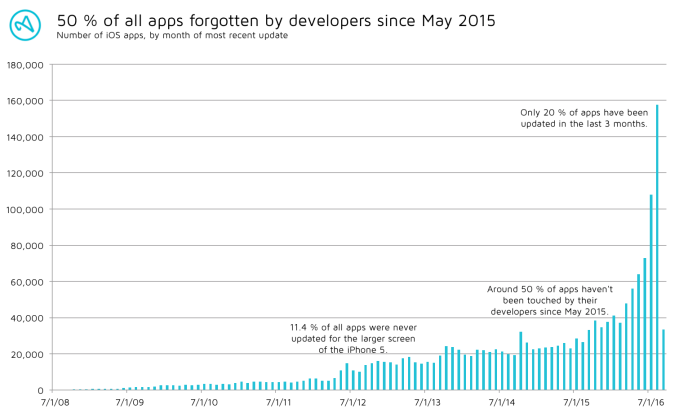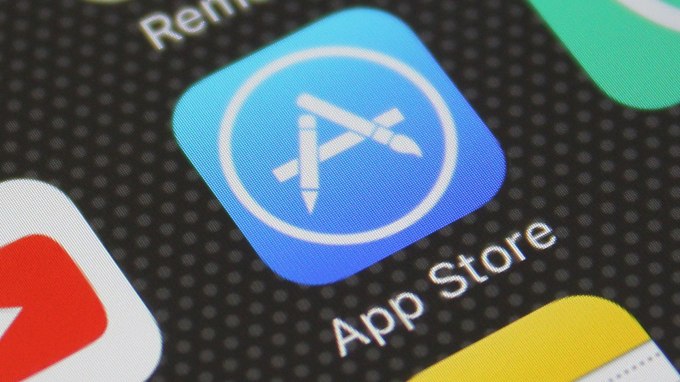Apple’s recently announced promise to clean up its App Store by removing old, outdated and non-compliant applications could see hundreds of thousands of apps getting booted from the mobile application marketplace, according to new data about the number of abandoned apps live on the storefront today. Apple, of course, didn’t specifically detail its criteria for kicking out older apps – saying only that apps that “no longer function as intended,” “follow current review guidelines,” or haven’t been supported with compatibility updates for “a long time,” could be removed.
That latter item, however – “a long time” – is where there’s room for speculation on the impact this purge will have on the App Store. How long is long, after all? That’s unclear.
Still, it’s fairly surprising how many apps have been released, but not maintained, when you dig into the numbers.
Top, active app developers update their apps at least every month or two, if not more frequently. In fact, a report from last year found that the top iOS developers averaged 45 days in between updates on average. Smaller and indie developers may not have the resources to maintain quite as fast-paced a schedule. But it’s still reasonable to think that an actively maintained app would at least be updated annually, as a minimum, or when a new iOS operating system was released or new hardware arrives.
Most apps aren’t, though.
There are 2.1 million active apps on the App Store worldwide today. But, according to data from Adjust, a business intelligence firm for app marketers, 50 percent of all apps have been abandoned by developers since May 2015. With half the App Store potentially up for deeper examination, Apple’s marketplace could soon look a lot different, following the upcoming purge.

In addition, a quarter (25.6 percent) of all iOS apps haven’t been updated since November 2013, Adjust says. And only 20 percent of apps have been updated in the last three months. This gives you an idea of how few apps are maintained after their App Store debut.
Meanwhile, one group of apps that’s likely to get kicked out of the App Store are those which were never updated to support the larger screen of the iPhone 5 (and subsequent models). Adjust says 11.4 percent of all apps fit this description, and 10 percent of all iOS apps haven’t been touched by their developers since the days of the iPhone 4.
Another way of looking at the situation is to count how many apps are truly ancient and abandoned. According to data from another app intelligence firm, Sensor Tower, 328,000 iOS apps haven’t been updated in three or more years. It wouldn’t be surprising to see all of those put on notice. Meanwhile, Sensor Tower says that roughly 40 percent of apps were updated in the last three months, according to its data, and 7.5 percent don’t support the iPhone 6 or newer.
We’ll soon know how Apple decides which apps it will remove, as it plans to begin reviewing and removing applications from the App Store starting tomorrow – the same day as its iPhone 7 event. Those that crash upon launch will be removed immediately, the company says, while other affected developers will have 30 days after receiving a request from Apple to submit an update, otherwise their app will be removed.

Though Apple’s actions will likely remove a great number of mobile applications, those that disappear largely won’t be missed. Having non-maintained apps that don’t work or even don’t look and feel current contributes to a poor user experience, and it makes finding newer, quality apps more difficult for end users.
The App Store purge is one of several, radical changes Apple has been rolling out to its App Stores in recent months, following the installation of Phil Schiller as the head of the App Store in December. The company also announced the introduction of search ads, new auto-renewable subscriptions with a more favorable rev share for developers, more pricing flexibility for subscriptions, a more personalized App Store which recommends apps users don’t already have installed, and more.
Alongside the App Store purge, Apple also said it plans to limit the way developers can use app names for better App Store SEO – that is, names can’t be longer than 50 characters, so developers can’t cram a bunch of keywords into their app’s title anymore.
